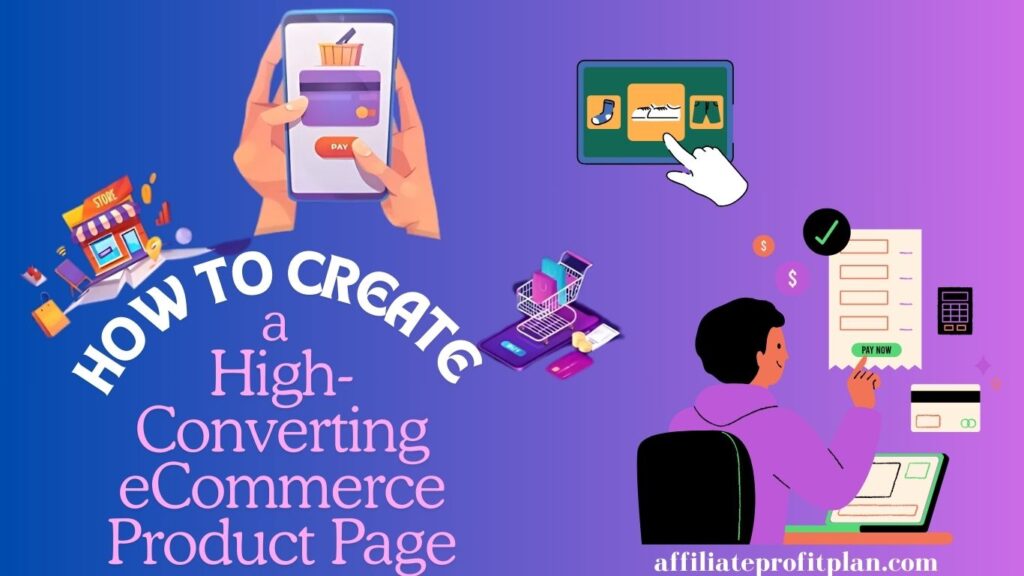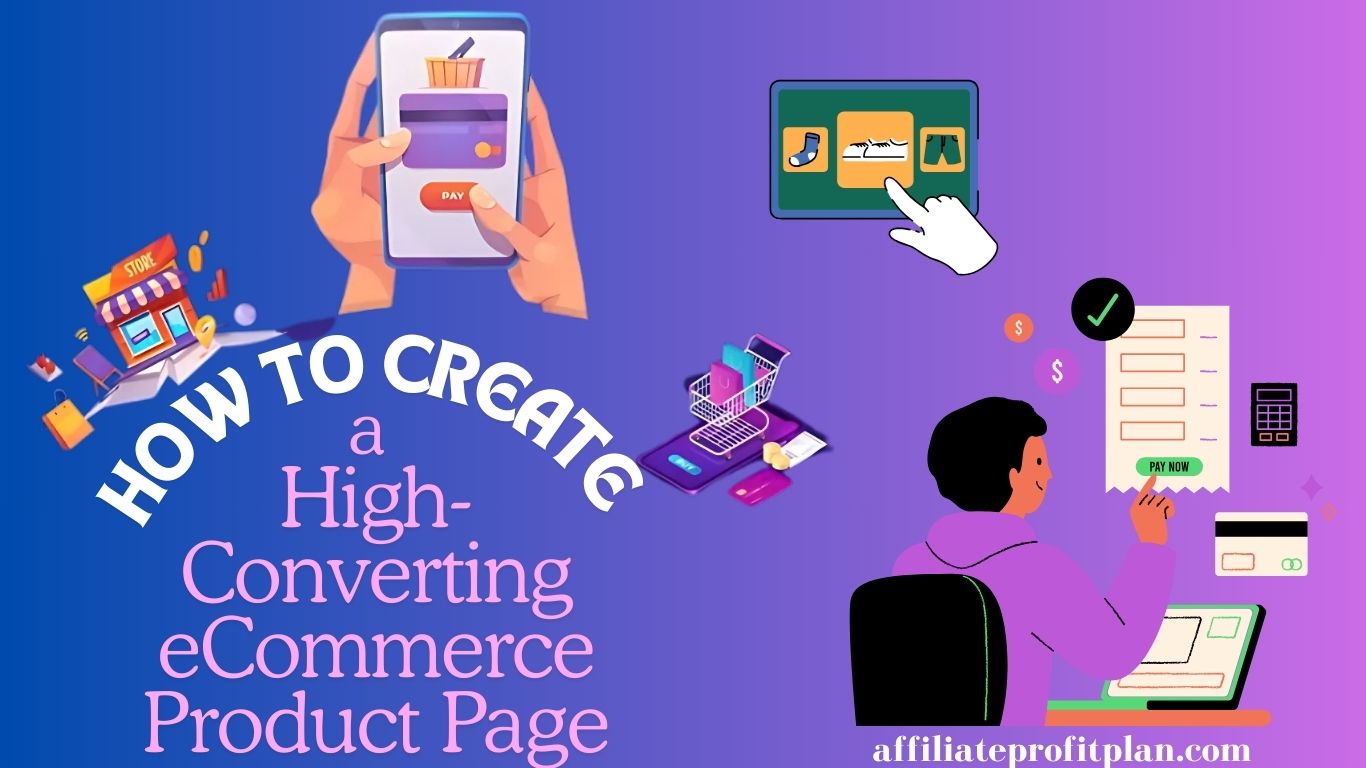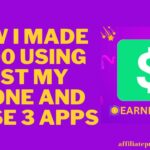Welcome to my article How to Create a High-Converting eCommerce Product Page. Creating a high-converting eCommerce product page isn’t just about slapping a price tag on a photo and calling it a day. It’s about carefully crafting a digital storefront that makes your products look so irresistible that customers can’t help but click “Add to Cart.” If you’ve ever wondered why some product pages seem to magically attract buyers while others leave customers cold, it often comes down to a few key tweaks. These changes might seem small, but in the world of online shopping, they’re like upgrading from “window shopper” to “repeat customer.”
In this guide, we’re diving deep into the anatomy of a high-converting product page, from writing compelling product descriptions to adding those trust-building customer reviews. By the end, you’ll know exactly how to create a product page that’s optimized, informative, and inviting—one that makes your customers feel they’d be missing out if they didn’t hit that “Buy Now” button.
Access My Proven Blueprint for $50-$100 Daily Income – Watch This FREE Video Now >>>

Crafting a Compelling Product Title and Description
When it comes to crafting a compelling product title and description, think of them as your digital version of a confident first impression. This is your chance to grab the customer’s attention and give them a reason to stick around, so make it count! A clear, catchy title and a description that speaks to what they really want (rather than just the specs) can be the difference between a quick glance and a full-on purchase.
Creating the Perfect Product Title
Your product title is like the headline of an irresistible story. It needs to be clear and informative but also catchy enough to stand out. Avoid jargon and technical terms that might confuse shoppers—use language your ideal customer would use. And if you’re tempted to make it a little too clever, remember that clarity wins over wit here. Ideally, your title should tell the shopper exactly what the product is, its primary feature or purpose, and any standout characteristics. For example, “Organic Cotton Yoga Blanket – Super Soft, Eco-Friendly, Hypoallergenic” tells the customer everything they need to know in one quick glance.
And don’t forget keywords! A well-optimized product title makes it easier for search engines (and therefore, customers) to find you. But rather than stuffing in every SEO term under the sun, pick one or two high-impact keywords that naturally fit the product title. This way, you’ll still come across as a pro, not a bot.
Writing a Description That Sells
A great product description goes beyond “what” and taps into “why.” Instead of simply listing the features, talk about the benefits those features bring. Rather than saying, “This blender has a 1000-watt motor,” try, “This powerful 1000-watt motor makes morning smoothies a breeze, even with the toughest ingredients.” See the difference? You’re not just telling the customer what they get—you’re helping them picture how it improves their life.
Keep descriptions short, scannable, and friendly. Use bullet points for quick reading, especially for features, and add a little personality to keep things interesting. If your product has a unique origin story, or there’s something quirky about it that adds to its charm, let that shine through. Customers love feeling like they’re buying more than just an item; they’re buying an experience, a story, or a solution to a problem they didn’t know they had.
In short, the title and description should work together to hook the shopper, answer their questions, and persuade them that yes, they absolutely need this in their life. Make it visual, make it relatable, and make it sound like a conversation between friends—and watch those conversion rates rise.
Using High-Quality, Engaging Product Images and Videos
In the world of online shopping, visuals are everything. Since customers can’t actually pick up your product, feel its texture, or take it for a test spin, your images and videos have to do all that heavy lifting. And let’s be real—no one ever fell in love with a blurry, badly lit product shot. High-quality, engaging images and videos can be the deciding factor that turns a casual browser into a committed buyer.
Nailing the Basics: Crisp, Clear, and True-to-Life Images
First and foremost, your product images should be crisp and clear, with accurate colors and details that look as close to the real thing as possible. A sharp, high-resolution image says, “This is a professional operation,” while a pixelated or dark photo says, “I’m not sure I want to spend my money here.” The goal is to give customers a sense of how the product would look in their own hands, so avoid unnecessary filters or editing that might distort the actual appearance of the product.
Variety is the Spice of Conversion
When it comes to product images, one shot just won’t cut it. Show the product from multiple angles: front, back, sides, and a close-up for any interesting details. If there’s a unique texture, stitching, or design element, make sure that gets its moment in the spotlight. And don’t just go for the standard “floating in a white box” look—show the product in context! For example, a beautifully staged lifestyle shot of a coffee mug on a cozy breakfast table tells a story and helps customers imagine themselves using it.
Adding a few lifestyle images with people interacting with your product can also be a huge plus. This brings your item to life and helps potential customers visualize how it might fit into their daily routine. Plus, it adds that all-important human touch.
The Magic of Product Videos
Images are great, but videos are where the magic really happens. A short, engaging video lets you show the product in action, answer FAQs visually, and highlight those features that are hard to capture in a photo. Think of it as a mini-commercial: show how the product works, how easy it is to use, and what makes it special. Whether it’s a demo of a blender making a smoothie in seconds, a look at the fit and movement of a jacket, or a hands-on close-up of an electronic gadget, a well-done video can be the virtual version of “try before you buy.”
Even a simple 360-degree view or a “hands-on” clip that lasts a few seconds can boost conversion rates. People spend more time on product pages with videos, and more time on a page usually means a higher likelihood of hitting “add to cart.” So even if you don’t have a Hollywood budget, a few seconds of clear, well-lit footage can go a long way.
Attention to Detail
Finally, don’t forget the little things, like alt text for images (helpful for SEO and accessibility) and using video captions for customers who are scrolling with the sound off. These small details not only improve the shopping experience but also show that you’ve thought of everything. So, when it comes to visuals, think quality over quantity and let your images and videos tell a story that says, “This product was made for you!”
In summary, your images and videos are the silent salespeople of your product page. Make them compelling, make them true-to-life, and make sure they tell a story worth buying into.
Incorporating Customer Reviews and Social Proof
Customer reviews and social proof are like the friendly nudge from a friend saying, “Yes, you’re making the right choice!” In a world where we’re constantly bombarded with marketing claims, real-life feedback from other buyers carries serious weight. Incorporating genuine reviews and other forms of social proof can turn skeptics into shoppers faster than any promo code or discount. It’s a simple but powerful way to build trust, so let’s talk about how to do it right.
Access My Proven Blueprint for $50-$100 Daily Income – Watch This FREE Video Now >>>
Showcasing Genuine Reviews
First things first: authenticity is everything. When adding reviews, make sure they’re unfiltered and genuine. Shoppers can sniff out fake or overly polished reviews from a mile away, so keep things real—even if it means showing a few 4-star ratings here and there. A mix of honest feedback actually boosts credibility and reassures customers that they’re seeing the full picture. Highlight the features that customers rave about, but let potential buyers read about any minor downsides too; after all, no product is perfect, and transparency goes a long way.
Make Reviews Easy to Find
It’s not enough to just have reviews on your product page; you want them to be easy to find and even easier to read. Consider placing the review section right below the product description or using a sidebar that previews ratings, so users can see customer feedback without scrolling forever. Adding a few “featured” reviews at the top of the page is a great way to showcase some of the best comments. And if your product has earned raving feedback, display the overall rating proudly near the product title—it’s a quick way to catch attention.
Bring in Photos and Videos
Nothing boosts credibility like seeing actual customers using your product in real life. If your review platform supports it, encourage customers to upload photos or videos with their reviews. These visual testimonials not only give potential buyers a clearer sense of what to expect but also add that human touch that people find reassuring. A snapshot of someone happily wearing the shirt you’re selling or a video showing your coffee maker brewing the perfect cup can speak louder than any written testimonial.
Display Social Media Mentions and Influencer Shoutouts
Beyond reviews, you can use social media as a powerful form of social proof. If customers are tagging you on Instagram or TikTok, showcasing your products in action, consider embedding these posts on your product page. A live feed of customer posts or selected testimonials gives your page a fresh, interactive feel and shows visitors that people are excited about your product in the real world.
Likewise, if a reputable influencer or blogger has reviewed your product, don’t be shy—showcase that! A quote or short video from a popular figure adds a level of authority that regular reviews can’t quite match. Just make sure the endorsement feels authentic and aligns with your brand; forced influencer shoutouts can sometimes backfire if they feel too salesy or off-brand.
Leverage Numbers to Boost Confidence
If you’ve got a high volume of reviews or have reached certain milestones (like “10,000 happy customers”), let your audience know! Displaying the number of reviews or rating stats can give a sense of reliability, especially to first-time visitors who may be on the fence. Even something like “Rated 4.8 by over 5,000 customers” signals that many people have trusted your product—and that most of them were thrilled with it.
In short, customer reviews and social proof aren’t just add-ons to a product page; they’re essentials for building trust, credibility, and a connection with your audience. Whether it’s through honest reviews, real-life photos, or influencer nods, give your potential customers that extra boost of confidence they need to hit “add to cart” with a smile.
Creating a Clear Call-to-Action (CTA) and Simplifying the Checkout Process
A well-crafted call-to-action (CTA) is like a gentle (but persuasive) tap on the shoulder, saying, “Here’s where the magic happens!” Your CTA is where interest turns into action, so it should be as clear and compelling as possible. But the magic doesn’t end there—once they click, you want a smooth, streamlined checkout process to seal the deal without a hitch. Let’s look at how to master these two essential elements of high-converting eCommerce pages.
Making Your CTA Pop
The first rule of a successful CTA: keep it simple. This isn’t the time for “learn more” or “maybe think about adding this to your cart.” Instead, go for direct, action-oriented phrasing like “Buy Now,” “Add to Cart,” or even “Get Yours Today.” These simple, active phrases leave no room for hesitation. They tell the customer exactly what to do next—no guesswork, no confusion, just action.
Color and placement are just as crucial as the wording itself. Make sure your CTA button stands out visually from the rest of the page. A bright, contrasting color that aligns with your branding can work wonders in catching the eye. And don’t hide it at the bottom of a long product description—place the button above the fold, near the product title or price, so it’s one of the first things people see. If your page is longer, don’t hesitate to include additional CTAs strategically placed throughout.
Use Urgency or Limited Offers (but Don’t Overdo It)
If appropriate, adding a subtle sense of urgency can nudge hesitant buyers. A simple “Only a few left in stock!” or “Limited-time offer!” can create that slight FOMO effect that encourages customers to act now rather than later. Just be cautious—if everything on your site is “LIMITED TIME!” it starts to feel like an infomercial instead of an authentic offer. Pick and choose where to use this tactic for the best results.
Smooth and Streamline the Checkout Process
Once your CTA has done its job, you want to make the rest of the buying journey feel as smooth as possible. Think of your checkout process as a well-paved road, free of potholes and unnecessary detours. Start by reducing the number of steps it takes to complete the purchase. Every additional field or step is an invitation for hesitation, so aim for a minimalistic, user-friendly design that keeps customers moving forward.
If possible, offer a guest checkout option. Not everyone wants to create an account just to buy a pair of socks, and forcing registration can lead to cart abandonment. If signing up is important, give the option to do it after checkout as a convenient follow-up.
Keep Payment Options Simple and Transparent
Everyone’s got a preferred way to pay these days, so offer multiple payment options like credit card, PayPal, or other popular gateways to accommodate different preferences. Make sure there are no hidden fees, and show a clear breakdown of costs before the final “Place Order” click. Surprises are great in birthday presents, not in checkout screens.
For mobile users, make sure the payment process is optimized for smaller screens. Auto-fill options, larger buttons, and mobile-friendly designs can drastically reduce checkout friction and improve conversion rates. After all, mobile commerce is on the rise, and a checkout process that works like a dream on desktop but feels like a nightmare on mobile can turn off a huge chunk of potential buyers.
Add a Friendly, Reassuring Touch at the End
A small confirmation message can go a long way. Whether it’s a “Success! You’re just moments away from receiving your order confirmation,” or a thank-you note with an order summary, this final step reinforces a positive buying experience and can help reduce any post-purchase regret. And if you’re able to offer order tracking, a follow-up email with a “Track Your Package” link can add a helpful, professional touch.
In short, your CTA and checkout process should make the shopping experience as straightforward and pleasant as possible. With a clear, enticing CTA and a checkout process free from friction, you’re setting the stage for higher conversions and happier customers. It’s the perfect combo for a product page that not only sells but also delights.
Optimizing for Mobile and Enhancing Page Speed
When it comes to eCommerce, mobile optimization and page speed are your best friends—and your customer’s too. With more than half of all online shopping happening on mobile devices, a slow, clunky, or hard-to-navigate mobile page can send potential buyers running faster than you can say “checkout.” Let’s explore how optimizing for mobile and enhancing page speed can make your product page a high-converting powerhouse.
Mobile Optimization: Making Every Inch Count
A mobile-optimized site isn’t just about shrinking down your desktop page to fit on a smaller screen. It’s about rethinking the layout, minimizing distractions, and ensuring that everything is thumb-friendly. Key elements like the product title, price, CTA button, and images should all be prominently visible above the fold. Avoid overwhelming visitors with too much information at once—on mobile, simplicity is the golden rule.
Responsive design is crucial. Ensure your site adapts seamlessly to different screen sizes and orientations, from smartphones to tablets. Navigation should be intuitive, with easy-to-tap buttons and menus that don’t require Olympic-level precision to click. Consider integrating mobile-specific features, like a “sticky” CTA button that follows the user as they scroll, keeping the “Buy Now” option only a thumb-tap away.
Fast Loading Speeds: Because Seconds Count (Literally)
Page speed isn’t just a nice-to-have; it’s essential. According to research, every second of delay in page load time can result in a significant drop in conversions. That’s why optimizing page speed should be a top priority. Start by compressing images. While high-quality product images are crucial, they don’t need to be in high-res 4K glory on mobile. Use compressed, optimized images that load quickly without sacrificing quality.
Next, consider minimizing page elements. The fewer elements your page has to load, the faster it will be. Remove any unnecessary plugins, scripts, or fancy animations that may look cool but don’t add much to the shopping experience. A simple, lightweight page will load faster and keep customers engaged.
Leverage Browser Caching and Lazy Loading
To further boost speed, enable browser caching so that returning visitors don’t have to reload every element each time they visit. Browser caching stores elements of your site temporarily, which reduces load time on repeat visits and helps mobile users with spotty connections get a better experience.
Additionally, lazy loading is a technique that loads images only when they come into view on the screen. This way, visitors don’t have to wait for the entire page to load at once, which can be especially handy for pages with multiple product images or long descriptions.
Reduce Redirects and Improve Server Response Time
Redirects are sometimes necessary, but they’re also a page speed killer. Every time a page redirects to another, it slows down the load time. Try to keep redirects to a minimum, particularly on mobile where every extra second counts even more. Meanwhile, improving server response time—how long it takes your server to start loading the page—is equally important. A faster server often means a faster site, and this can be achieved by choosing a reliable web hosting provider and regularly monitoring your site’s performance.
Prioritize Core Web Vitals
Google’s Core Web Vitals are performance metrics that focus on page speed, interactivity, and visual stability. Pay particular attention to three metrics: Largest Contentful Paint (LCP), which measures loading performance; First Input Delay (FID), which measures interactivity; and Cumulative Layout Shift (CLS), which measures visual stability. If these terms sound intimidating, don’t worry; tools like Google PageSpeed Insights or GTmetrix can help you assess these metrics and offer suggestions on how to improve them.
Test and Tweak for Ongoing Optimization
Mobile optimization and speed enhancement aren’t one-and-done projects. Regular testing is key to catching any lag issues before they start impacting user experience and conversions. Use tools like Google’s Mobile-Friendly Test to ensure your site is continually providing an optimal experience on all devices. A/B testing can also be valuable here—try testing different mobile layouts, loading techniques, or button placements to see what truly resonates with your mobile audience.
In short, optimizing for mobile and ensuring fast load times aren’t just “good-to-haves” in eCommerce—they’re “must-haves.” With an optimized mobile layout and speedy load times, your product page becomes a quick, seamless experience that’s primed to convert. So, keep things fast, light, and user-friendly, and watch as mobile users go from browsers to buyers in no time.
Conclusion
And there you have it—a high-converting eCommerce product page that not only showcases your products beautifully but also makes it nearly impossible for customers to leave without hitting that “Buy Now” button. We’ve covered the essentials: crafting catchy titles and descriptions, adding jaw-dropping visuals, building trust through reviews, simplifying the checkout process, and optimizing for mobile speed. Each of these elements plays a vital role in turning casual visitors into enthusiastic buyers.
Access My Proven Blueprint for $50-$100 Daily Income – Watch This FREE Video Now >>>
Creating a high-converting product page isn’t about reinventing the wheel; it’s about refining it to roll as smoothly as possible. You’re guiding potential buyers on a journey, making sure every click, scroll, and swipe leads them closer to their purchase with minimal friction. It’s about clarity, ease, and just the right amount of persuasion—presented in a way that aligns with how today’s consumers actually shop.
Remember, a well-designed product page doesn’t just make a sale; it builds your brand’s credibility and keeps customers coming back for more. The effort you put into every product page sends a message: that your brand cares about the details and respects the customer’s time. And that’s a message people notice—and remember.
So, keep testing, tweaking, and optimizing your pages based on data and feedback, because the world of eCommerce never sits still. With a high-converting product page as your secret weapon, you’re setting up your store for success, one seamless shopping experience at a time. Now go on—give those pages the polish they deserve and watch as those conversion rates start climbing!
Thanks a lot for reading my article on “How to Create a High-Converting eCommerce Product Page“ till the end. Hope you’ve helped. See you with another article.










